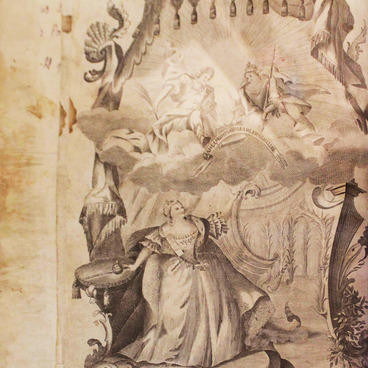This Cuman stele was found in 1882 near the village of Politovo of the Tambov Parish (today it is the village of Mikhailovka in the Tambov Region). Scholars believe it was made in the 10th century AD. The stone is about 25 cm thick.
The stone stele came to the Tambov Historical Museum in 1889. According to the records made by the Tambov Academic Archival Commission, peasants were plowing soil in the Bobrov Parish on May 25, 1882. In the middle of a mound their plow came across something hard. When they dug soil, they saw a stone with an image of human figure, and another one under it, without images, as a sort of a stand. The plowmen sold their find to a Politovo peasant Yegor Klokov for a quarter of wine. From Klokov, the trophy found its way to the Melgunovo Regional Government, and, after that, to the governorate’s academic archival commission and the museum.
Peasants said back then that the village of Politovo had been founded in the steppe about 100 years before. At the time, there was a small hillock in the place where the Cuman stele was discovered. As decades slipped by, it had increasingly been shrinking because peasants plowed the land. The surprising find confirmed a local legend that many centuries before barren steppe had been in lieu of Politovo, where nomadic idolaters used to dwell for a while. One day, for an unknown reason, they supposedly had to flee the land in a hurry. They probably concealed the statue that they worshipped in a mound. The commission did not record any other folk tales. The story of the Cuman stele discovery was printed by the Tambov Governorate Vedomosti (i.e. Bulletin) in 1884.
Stone stelae like the one found in the Tambov Region were objects of sacred art of the Cumans, a Turkic nomadic people. Stone statues with carved relief or faces symbolized their ancestors. They were portrayed as strong warriors, or the figures and faces were made to have female features. The hands were usually depicted either folded on the abdomen, by tradition, or holding a vessel. Female stelae were believed to inspire power in warriors and give protection to them, and sacrifices were frequently performed near those figures. The Cumans called their statues “idols” — the Turkic word for that sounds like balbal. The Russians assimilated it to the word baba (lit.: a peasant woman), so it became the usual denomination for all discovered Cuman statues.
The stone stele came to the Tambov Historical Museum in 1889. According to the records made by the Tambov Academic Archival Commission, peasants were plowing soil in the Bobrov Parish on May 25, 1882. In the middle of a mound their plow came across something hard. When they dug soil, they saw a stone with an image of human figure, and another one under it, without images, as a sort of a stand. The plowmen sold their find to a Politovo peasant Yegor Klokov for a quarter of wine. From Klokov, the trophy found its way to the Melgunovo Regional Government, and, after that, to the governorate’s academic archival commission and the museum.
Peasants said back then that the village of Politovo had been founded in the steppe about 100 years before. At the time, there was a small hillock in the place where the Cuman stele was discovered. As decades slipped by, it had increasingly been shrinking because peasants plowed the land. The surprising find confirmed a local legend that many centuries before barren steppe had been in lieu of Politovo, where nomadic idolaters used to dwell for a while. One day, for an unknown reason, they supposedly had to flee the land in a hurry. They probably concealed the statue that they worshipped in a mound. The commission did not record any other folk tales. The story of the Cuman stele discovery was printed by the Tambov Governorate Vedomosti (i.e. Bulletin) in 1884.
Stone stelae like the one found in the Tambov Region were objects of sacred art of the Cumans, a Turkic nomadic people. Stone statues with carved relief or faces symbolized their ancestors. They were portrayed as strong warriors, or the figures and faces were made to have female features. The hands were usually depicted either folded on the abdomen, by tradition, or holding a vessel. Female stelae were believed to inspire power in warriors and give protection to them, and sacrifices were frequently performed near those figures. The Cumans called their statues “idols” — the Turkic word for that sounds like balbal. The Russians assimilated it to the word baba (lit.: a peasant woman), so it became the usual denomination for all discovered Cuman statues.



